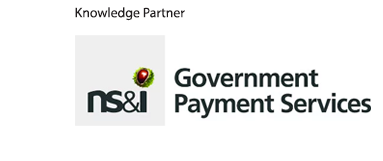The battle of the data strategies

When ChatGPT was invited to pick a winner, a session on data strategies took on an unexpectedly competitive tone at the Government Digital Summit. Would the UK or Canada win this strategy slamdown?
“Data is owned in all sorts of different places – and if you’re a data owner, the incentives for you to share that data are not yet quite in the right place,” said Alison Pritchard. “We focus on the risk of data going astray; we don’t focus enough on the risk of data not being used effectively to improve people’s lives.”
Pritchard, who is the UK’s Deputy National Statistician and director general for data capability at the Office for National Statistics (ONS), was exploring civil servants’ risk management on data issues – a topic close to her heart – at the Government Digital Summit: a gathering of more than 50 senior digital leaders from 15 countries, focused in this final session on how to lay the groundwork for a data-based revolution in public services.
This revolution has huge potential to improve public services, economic growth and public sector efficiency; but these opportunities will only be realised if civil servants are able to make full use of governments’ vast data assets. And in the closing hours of the event, the participants heard how both the UK and Canada aim to achieve that goal – with Pritchard and Stephen Burt, Canada’s Chief Data Officer, setting out their data strategies. “I’m calling this the battle of the data strategies,” said facilitator Siobhan Benita. “You can see the competitive edge.”
The UK takes the ring
When the ONS published its Data Strategy 2023-25, explained Pritchard, it was “the first time we set out a strategic perspective on the areas where we need to make progress.” The strategy contains eight ‘missions’, explaining how progress against each will be measured; and it is ambitious in envisaging how public bodies could make data central to decision-making and service delivery. “This takes our data environment and puts it at the heart of the operational purpose of the organisation,” said Pritchard – providing the strengthened data architecture, management, quality and security required to turn government datasets into a “strategic tool”.
The strategy tasks ONS with developing services to support data users across government – including an Integrated Data Service, a central hub offering accessible, high-quality linked datasets for accredited civil service and academic researchers – and pays careful attention to the issues around public trust, privacy and ethics. The eight missions “indicate the areas where we want to make continual progress over the next couple of years,” Pritchard concluded, putting in place the “foundational elements that unlock the potential of data.”
Up steps Canada

Next up, Stephen Burt presented Canada’s 2023-26 Data Strategy for the Federal Public Service as a shift from “insurgency” to “revolution” for the government’s data specialists. The country’s previous strategy, published in 2018, was “an exhortation to do better; a call to arms,” he commented. But it didn’t put in place the powers, tools and support required to catalyse action across government, and progress eventually “petered out”. To make a substantive difference to government’s use of data, “you have to be prepared to take over and do stuff – not just be the insurgents,” he added.
As a result, the new strategy “is about execution and delivery, rather than exhortation,” he explained – with four missions focusing on data by design; data for decision-making; enabling data-driven services; and empowering the public service. The first of these sets out plans to “clarify data leadership responsibilities within and across” the public service; Burt made clear that his office will be acting “to support interoperability and data reuse” by, for example, introducing common data standards. But central leaders cannot catalyse widespread change without a “network of trusted agents,” he said: senior digital leaders “that you can mobilise, and set loose with some confidence that they’re going to deliver tangible progress within their departments and agencies.”
These leaders will in turn need the support of an educated and engaged workforce. “We’ve got to mobilise the grassroots,” said Burt, building up “their knowledge base, and the tools they’ve got to use data effectively.” Here, initiatives such as the Public Service Data Challenge – a staff engagement and innovation programme, run with Global Government Forum, which identifies and promotes public servants’ data ideas – “help energise the system,” he commented. “It makes a huge difference in terms of mobilising people’s imaginations and getting them into this space.”
It’s good to share
Both data leaders having outlined their strategies, Benita moved to questions – and the first was from Erica Ren, chief data officer of Immigration, Refugees and Citizenship Canada. Her department oversees “a really complex data-sharing eco-system: we have many data-sharing agreements with various provinces, territories, institutions, international partners,” she said, asking Pritchard how the UK government gathers and uses data with partners across and beyond the public sector.
Providing a secure, valuable data-sharing platform can help, Pritchard replied, pointing to the Integrated Data Service: “A cloud-native, trusted research environment, which allows us to bring together data with a consistent linking strategy called the reference data management framework.” Ultimately, though, she suggested that changes to the legislative environment are required: “We’re still relying on legislation that was developed for the collection and protection of data, not for its active utilisation,” she said, adding that many civil servants focus on how laws restrict data-sharing rather than looking for ways in which they permit it.
Burt quite agreed. “I do think we, on the data-sharing front, are going to need a legislative refresh,” he said. “I’m quite struck with what our Australian colleagues have done with their Data Sharing and Transparency Act, which was intended to break down some of the barriers in departmental legislation.” The obstacles to data-sharing more often lie in the specific legislation governing each departments’ operations and service delivery, he added, than in privacy laws – which tend to be “quite principles-based and open-ended.”
Making data available to the private sector can also generate benefits, said Barna Gaal, head of international relations at Digital Agency Hungary – enabling businesses to build new products and services. “Such models could prove that the data economy will bring us economic growth and additional income in taxes,” he commented. “What’s your experience?”
Government data fundamentally belongs to citizens, not departments, said Pritchard, emphasising that this brings a responsibility to allow the public to make use of its information: the ONS is looking at ways to release more raw census data, for example. “Our job is to find the effective and ethical way of allowing that data to be used,” she said. The UK, Pritchard added, also has a code of practice that requires politicians to publish the data used in formulating policies; this has “worked quite well for us,” she noted.
Judge ChatGPT gives its verdict

As the two data leaders’ responses to questions made clear, their goals and challenges – and, thus, their strategies – have much in common. But there were significant differences, and Pritchard – tongue firmly in cheek – set out the research she’d conducted to decide which was best.
“We’ve talked a lot about AI today,” she commented (see our report on session 3). “And I decided not to do the work myself, but to ask ChatGPT to look at these two strategies.” The first question she’d put to it, she added, was: “Which strategy is better? I wanted to see how far ChatGPT would go in provoking an international incident!”
As it turned out, the AI software demonstrated advanced diplomatic skills – noting that “both strategies are robust and tailored to the specific needs and contexts of each country.” Canada’s, it explained, emphasises modern governance and “has a unique focus on indigenous data sovereignty,” while the UK’s is “operationally detailed, emphasizing data acquisition, quality, and public trust.”
This verdict, Pritchard concluded, represented a “score draw. I think ChatGPT was pretty much on the fence – so I decided to push it a bit harder.” Asked which strategy is more ambitious, the algorithm did venture an opinion: “The UK’s ONS Data Strategy appears to be more ambitious in terms of operational depth, technological advancement, and transformative goals,” it said – though it was quick to add that Canada’s focus on Indigenous data sovereignty represented a “unique and ambitious” goal.
Finally, Pritchard continued, she’d asked ChatGPT: “Which strategy is most likely to succeed?” Both strategies face potential challenges, it replied. The UK’s, with its “detailed missions and operational focus, seems to have a clear path, but its ambitious goals might introduce complexities. Canada’s success will hinge on the specifics of its forthcoming implementation plan and its ability to align diverse federal organizations.”
“I thought that was really insightful,” commented Pritchard, supporting the AI’s comment that “the success of a strategy isn’t solely based on its content but also on its execution, the resources allocated, stakeholder buy-in, and the ability to adapt to changing circumstances.”
Off the drawing board
So ChatGPT’s conclusion meshed neatly with Burt’s presentation of a strategy that is, as he put it, “about execution and delivery… moving from that call to arms into something more structured.” After the excitement of insurgency and the tumult of revolution comes something much more methodical: delivery is “a grind,” said Pritchard, “working step by step, focusing on the foundational elements that really unlock the potential of data.”
As that work moves forward, digital and data leaders must meanwhile seek to interest their colleagues in the power of data – explaining and demonstrating how it can help them realise their goals in service delivery, operational efficiency and strategic decision-making. “I’m trying to incentivise senior leaders to improve their skill levels in data, and to understand their role in supporting culture change,” said Nadia Ahmad, chief data officer and Head of Evaluation at Global Affairs Canada. “Any ideas about how to engage senior people in improving their own data literacy?”
The key, replied Burt, is to understand your colleagues’ “pain points” and demonstrate how data can help alleviate them. “You don’t need a digital problem to fix with digital solutions,” he said. “The point is to fix real-world problems with digital and data-driven solutions.” The other side of this coin, added Pritchard, is the need to appoint and empower really senior data leaders, so that other top executives hear “the voice of data at the table. It’s no good if your chief operating officer is responsible for this, but has no interest in it; we need the voice of digital and data at board level.”
Build the tech, lead the people

As the Digital Summit drew to a close, Andre Mendes, chief information officer of the USA’s Department of Commerce, reflected on the progress made by civil service digital leaders over recent years. The period since the pandemic struck in 2020, he commented, has seen the rapid adoption of digital technologies in government. “In the absence of risk, we get calcified and delve into our own belly buttons; faced with external risk, we’re far nimbler,” he said. “Every time there’s a crisis, we emerge from it with a new set of technologies that turn out to be transformative in nature.”
Making full use of those technologies demands much more than technical expertise: data officials must show true leadership to overcome the social, financial and cultural challenges involved in changing people’s behaviours. As in any field of government operations, progress on data is “about the anthropological factors of change management, and how to go about navigating it without enough money to do it all,” said Mendes.
Hence the value of the Government Digital Summit, which had enabled top digital leaders from around the world to lay out their hopes, share their concerns, and learn from one another how to pursue their parallel missions. “Regardless of where you are, when it comes to technological evolution and management, the same patterns continue to emerge time after time,” Mendes concluded. “With all the richness of presenters from around the world, the themes are very much the same as those I’ve faced in my 40-year career. I’ve loved these sessions.”
While Government Digital Summit sessions are held in private, GGF produces these reports to reveal to our readers around the world the priorities and preoccupations of national digital leaders – checking before publication that participants are content to be quoted. Our four reports cover the four daytime sessions; we’ll link to the reports here as they’re published.
Practical plans: how to build a digital strategy that gets delivered
The shelves of governments around the world are groaning with digital strategies that laid out their ambitious goals – then collapsed on contact with reality. In this session, top leaders from around the world explored how to produce a strategy that generates real change.
The evolution of AI: fresh challenges and emerging opportunities
Digital leaders are as daunted by the risks around AI as they are excited by its potential to transform public services. In a fascinating debate, they explored how to realise its potential while dodging its dangers.
Winning the cyber arms race
Cyber criminals and hostile intelligence agencies present an ever-growing risk to your organisation’s systems, assets and reputation. Here, national IT chiefs identified the keys to security in a perilous digital world.
We’d like to express our gratitude to our knowledge partners, EY and Blackberry, whose support enabled us to provide this event at no cost to the public sector.























